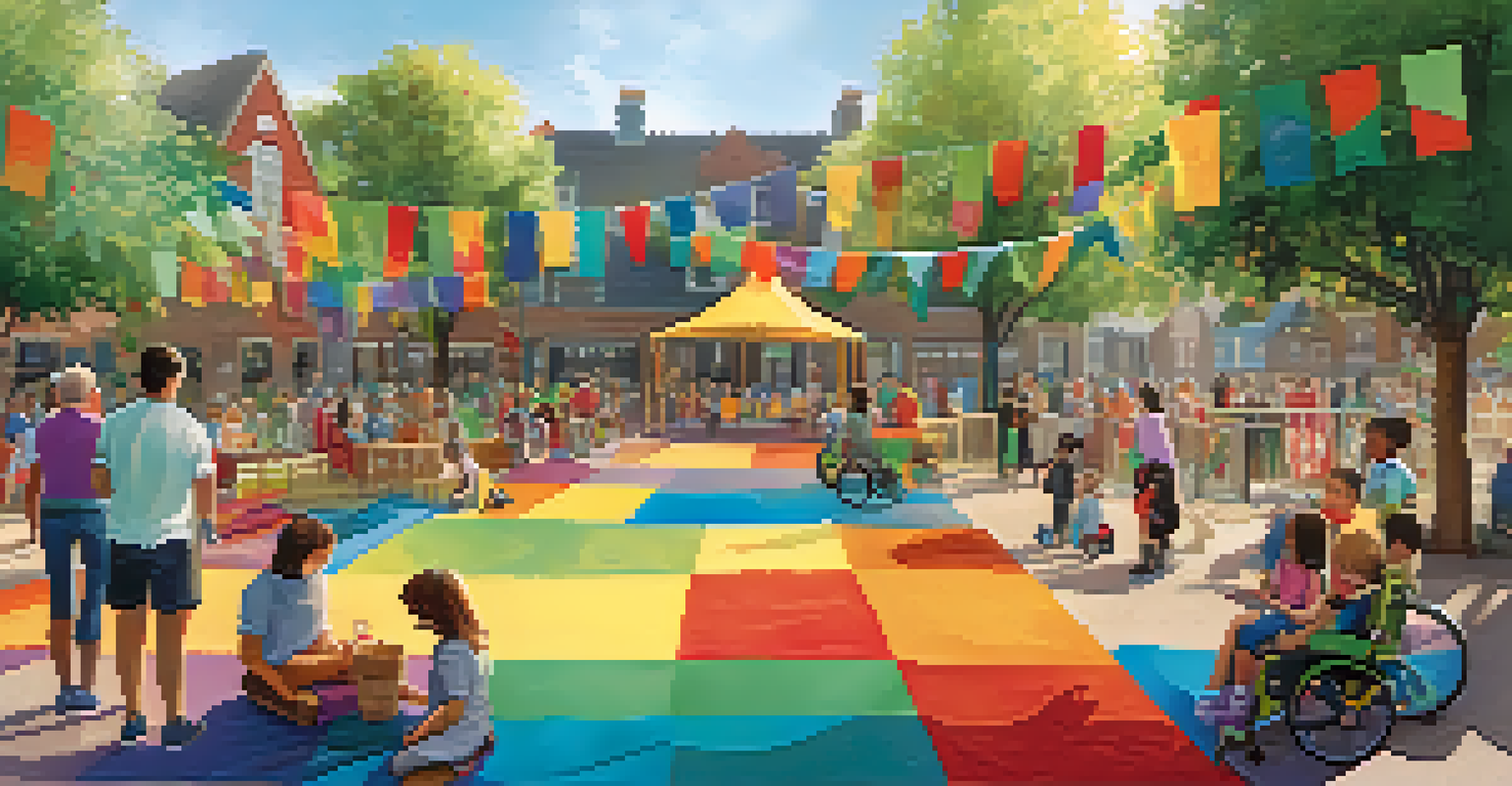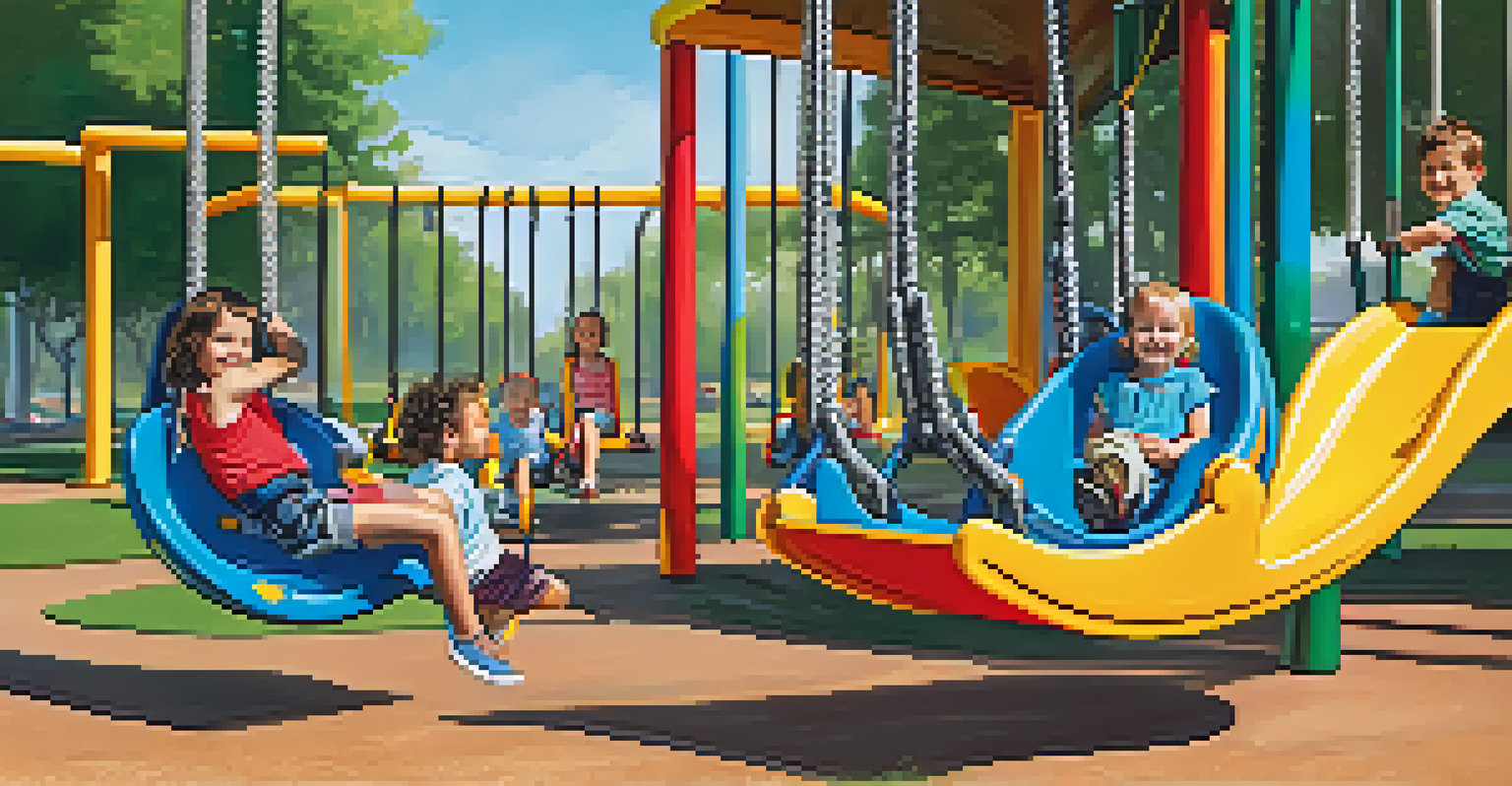Creating Accessible Play Areas for Children with Disabilities

Understanding the Importance of Accessible Play Areas
Accessible play areas are vital for ensuring that all children, regardless of their abilities, can enjoy outdoor activities. They provide a space where children can engage in play, develop social skills, and foster creativity. By prioritizing accessibility, we create an inclusive environment that promotes equality and acceptance among children.
Play is the highest form of research.
When children with disabilities have access to play areas, they experience numerous benefits, including improved physical health, emotional well-being, and enhanced cognitive development. Play is a fundamental part of childhood, and having accessible options allows all children to participate fully. This inclusiveness not only enriches the lives of those with disabilities but also educates their peers about diversity.
Moreover, inclusive play areas benefit families as well, allowing parents and caregivers to enjoy time together without worrying about accessibility issues. Creating these spaces is not just about compliance with regulations; it’s about fostering a community where every child feels valued and included.
Key Design Features for Accessible Play Areas
Designing accessible play areas requires careful consideration of various features that accommodate children with different abilities. For instance, using wide pathways ensures that children using wheelchairs or mobility devices can navigate the space comfortably. Additionally, incorporating ramps instead of stairs can make climbing structures accessible for everyone.

Another important aspect is the selection of equipment that caters to diverse needs. For example, swings with supportive seats allow children with limited mobility to enjoy swinging alongside their peers. Sensory play areas with tactile elements can engage children with sensory processing challenges, providing a multi-sensory experience that benefits all.
Inclusive Play Areas Benefit All Kids
Accessible play areas allow children of all abilities to engage in play, promoting social skills and creativity.
Finally, it's essential to incorporate inclusive signage and information that communicates the available features clearly. Using braille, high-contrast colors, and pictograms can help all children and caregivers understand how to use the equipment safely and effectively. These thoughtful design choices contribute to a welcoming environment where every child can thrive.
Involving Children with Disabilities in the Design Process
One of the most effective ways to create truly accessible play areas is to involve children with disabilities in the design process. Their insights and experiences can guide designers in understanding what features are necessary for enjoyment and safety. By listening to their feedback, we can ensure that the final design meets the needs of those who will use it most.
Inclusion is not a matter of political correctness. It is the key to growth.
Workshops and focus groups can be organized to gather input from children, parents, and caregivers about their preferences and challenges. This participatory approach not only empowers children but also fosters a sense of ownership and pride in the play area. When children see their ideas come to life, they are more likely to engage with the space.
Moreover, collaboration with specialists, such as occupational therapists and adaptive recreation experts, can provide valuable insights into the best practices for creating inclusive environments. By combining their expertise with the voices of children, we can design play areas that are both functional and enjoyable for everyone.
Community Engagement in Creating Accessible Play Areas
Community engagement plays a crucial role in the success of accessible play area projects. By rallying support from local organizations, businesses, and residents, we can raise awareness about the importance of inclusivity in play spaces. Fundraising efforts, volunteer days, and awareness campaigns can help transform ideas into reality.
Involving the community also fosters a sense of belonging and shared responsibility. When community members contribute to the creation and maintenance of accessible play areas, they develop a deeper connection to the space. This also encourages ongoing advocacy for inclusivity and accessibility in other public areas.
Community Involvement is Key
Engaging the community in the creation of accessible play areas fosters a sense of belonging and shared responsibility.
Moreover, showcasing the benefits of accessible play areas through community events can attract more visitors and support. Activities can include inclusive play days, workshops, and informational sessions that highlight the importance of accessibility, ensuring that everyone understands the value of these spaces.
Funding and Resources for Accessible Play Area Projects
Securing funding for accessible play areas can be a challenge, but there are numerous resources available to help communities achieve their goals. Grants from local governments, non-profit organizations, and foundations often focus on improving accessibility in public spaces. Researching and applying for these funds can provide the necessary financial support.
Additionally, crowdfunding platforms have gained popularity as a means to raise money for community projects. Engaging the community through online campaigns can generate excitement and support for the cause. Sharing stories about the importance of accessible play areas can inspire others to contribute, making the project a collective effort.
Collaborating with local businesses can also be a fruitful approach. Many businesses are eager to contribute to community initiatives that promote inclusivity, and in return, they gain positive exposure. By presenting a well-thought-out plan, communities can encourage local businesses to become partners in creating accessible play areas.
Evaluating and Maintaining Accessible Play Areas
Creating an accessible play area is just the beginning; regular evaluation and maintenance are essential to ensure its continued usability. Gathering feedback from users can help identify any issues or areas for improvement. This can be done through surveys, suggestion boxes, or community meetings that invite children and caregivers to share their experiences.
Maintenance is also crucial in keeping the play area safe and functional. Regular inspections can help identify wear and tear, ensuring that equipment remains in good condition. It's important to address any safety concerns promptly to maintain a welcoming environment for all children.
Ongoing Maintenance Ensures Usability
Regular evaluation and maintenance are essential to keep accessible play areas safe and functional for all users.
Moreover, adapting the play area over time to meet evolving community needs is important. As more children and families engage with the space, their preferences and requirements may change. By remaining open to feedback and making necessary adjustments, we can ensure that the play area remains a vibrant and inclusive space for generations to come.
Celebrating Inclusivity in Play Spaces
Once an accessible play area is established, it’s important to celebrate its opening and promote its inclusive nature. Hosting an inaugural event can bring the community together, allowing everyone to enjoy the new space and appreciate its design. Activities that showcase adaptive play can help demonstrate how all children can engage with the equipment.
This celebration not only highlights the achievements of the community but also reinforces the importance of inclusivity in play. Sharing stories from children who benefit from the new play area can inspire others and encourage advocacy for similar projects. It’s an opportunity to educate the wider community about the significance of accessibility in recreational spaces.

Finally, ongoing celebrations can help maintain enthusiasm and support for the play area. Organizing inclusive events, such as themed play days or workshops, can keep the community engaged and foster a culture of acceptance and understanding. These initiatives remind everyone that accessible play areas are valuable assets for all children.